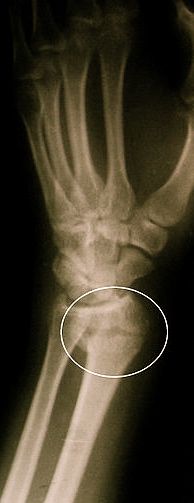You won’t know until you break (unless you look for it)

 If most of us were to stumble and then fall forwards, we probably would stop our fall with our outstretched hands. Would you find it surprising if this led to you breaking your wrist bone?
If most of us were to stumble and then fall forwards, we probably would stop our fall with our outstretched hands. Would you find it surprising if this led to you breaking your wrist bone?
If you were bumped and fell onto your buttock or the side of your hip, would you be surprised if you fractured your femur (hip bone)?
Should you expect to become much shorter as you enter your 7th or 8th decade of life?
Each year, numerous people, usually over the age of 60, develop such fractures.
The wrist or Colles fracture, and the femoral fracture (typically at the neck of the femur) can cause terrible pain followed by loss of function. In the case of a fracture of the femur, loss of life can result, and probably, worse still, loss of independence with up to 50% of sufferers ending up in a nursing home. Crush fractures of vertebrae can actually be silent, with the only sign being increasing curvature of the thoracic spine (kyphosis or “hunchback”).
These 3 types of fractures are examples of minimal-trauma fractures (also called fragility fractures), given that they occur with at a level of trauma that would not be expected to cause such damage. People who suffer such fractures typically have osteoporosis.
Osteoporosis is present when bone becomes fragile to the point that fractures occur without much trauma.
Osteoporosis is a very common disease. 1 in 2 women and 1 in 3 men over the age of 60 will sustain an osteoporotic fracture.
Effective treatment can prevent the first fracture. Effective treatment can prevent subsequent fractures.
Unfortunately, this disease tends to be silent, with the first symptom and sign of osteoporosis being the fracture. As a result of this, it is commonly undetected prior to fracture. It is estimated that less than 25% of people who suffer an osteoporotic fracture are on appropriate treatment, mainly because the disease is not considered and therefore untreated.
This is a shame, and needs to change. What do you think?
Dr Irwin Lim is a rheumatologist and a director of BJC Health. BJC Health provides coordinated, comprehensive, and colocated multidisciplinary care to achieve effective solutions for patients. We call this model of care, Connected Care. Our clinics are located in Parramatta, Chatswood and Brookvale. Contact us.
This blog focuses on musculoskeletal disease, healthcare in general, and our Connected Care philosophy.
